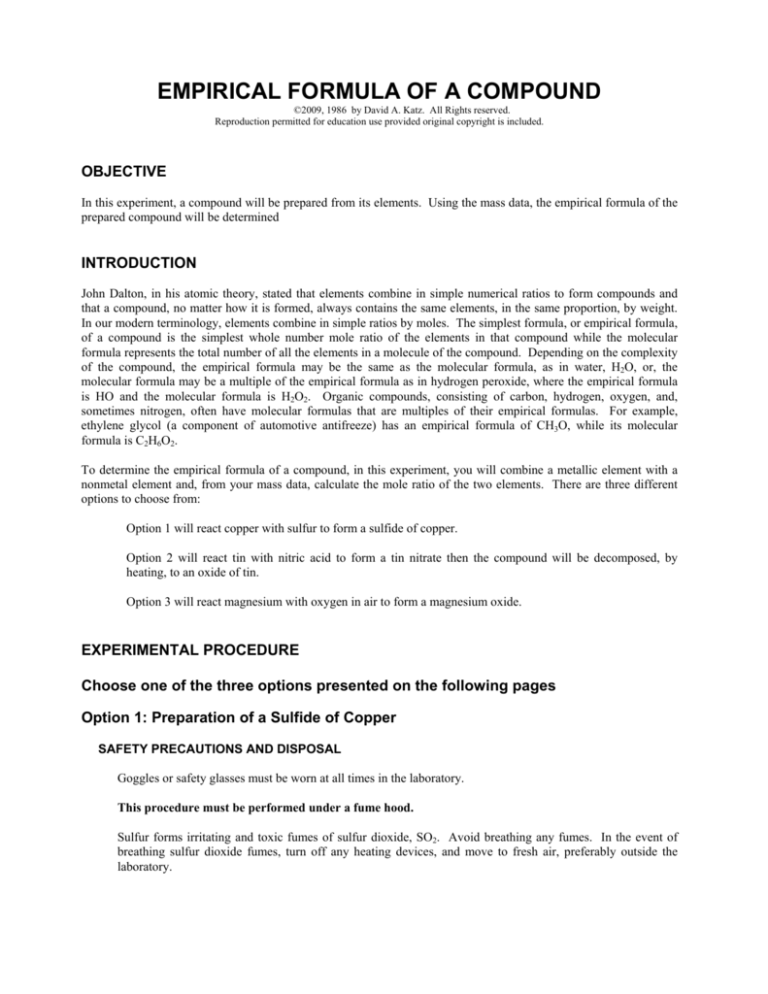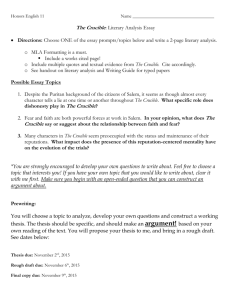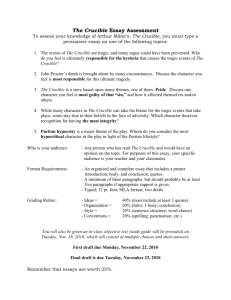
EMPIRICAL FORMULA OF A COMPOUND
©2009, 1986 by David A. Katz. All Rights reserved.
Reproduction permitted for education use provided original copyright is included.
OBJECTIVE
In this experiment, a compound will be prepared from its elements. Using the mass data, the empirical formula of the
prepared compound will be determined
INTRODUCTION
John Dalton, in his atomic theory, stated that elements combine in simple numerical ratios to form compounds and
that a compound, no matter how it is formed, always contains the same elements, in the same proportion, by weight.
In our modern terminology, elements combine in simple ratios by moles. The simplest formula, or empirical formula,
of a compound is the simplest whole number mole ratio of the elements in that compound while the molecular
formula represents the total number of all the elements in a molecule of the compound. Depending on the complexity
of the compound, the empirical formula may be the same as the molecular formula, as in water, H2O, or, the
molecular formula may be a multiple of the empirical formula as in hydrogen peroxide, where the empirical formula
is HO and the molecular formula is H2O2. Organic compounds, consisting of carbon, hydrogen, oxygen, and,
sometimes nitrogen, often have molecular formulas that are multiples of their empirical formulas. For example,
ethylene glycol (a component of automotive antifreeze) has an empirical formula of CH3O, while its molecular
formula is C2H6O2.
To determine the empirical formula of a compound, in this experiment, you will combine a metallic element with a
nonmetal element and, from your mass data, calculate the mole ratio of the two elements. There are three different
options to choose from:
Option 1 will react copper with sulfur to form a sulfide of copper.
Option 2 will react tin with nitric acid to form a tin nitrate then the compound will be decomposed, by
heating, to an oxide of tin.
Option 3 will react magnesium with oxygen in air to form a magnesium oxide.
EXPERIMENTAL PROCEDURE
Choose one of the three options presented on the following pages
Option 1: Preparation of a Sulfide of Copper
SAFETY PRECAUTIONS AND DISPOSAL
Goggles or safety glasses must be worn at all times in the laboratory.
This procedure must be performed under a fume hood.
Sulfur forms irritating and toxic fumes of sulfur dioxide, SO2. Avoid breathing any fumes. In the event of
breathing sulfur dioxide fumes, turn off any heating devices, and move to fresh air, preferably outside the
laboratory.
The crucible will become very hot in this procedure. Allow the crucible to cool before handling. Use crucible
tongs to hold the crucible.
Dispose of the copper oxide in the waste chemical container at the end of the experiment.
Materials needed:
Crucible and cover
Clay triangle
Crucible tongs
Copper wire or shavings, Cu
Sulfur, S, powdered
Procedure:
1. Prepare the crucible
If necessary, clean and dry the crucible and cover.
Place the crucible and cover on a clay triangle, supported on an iron
ring (See Figure 1). Heat the crucible gently for about one minute,
then heat strongly for about 5 minutes. Allow the crucible and cover
to cool. Handle the hot or cooled crucible and cover using your
crucible tongs. (See Figure 2)
Weigh the cooled crucible and cover and record the mass to 0.001 g.
Weigh the cover of the crucible separately, and record its mass. (This
second step will allow you to still determine your final results if the
crucible cover falls off the crucible and breaks during the
experiment.)
Figure 1. Heating a crucible
2. Weigh 0.400 to 0.500 g of copper wire or shavings. Roll the copper into a loose coil or loose ball. Place the
copper into the crucible and weigh the crucible, cover, and copper together. Record the mass to 0.001 g.
3. Weigh 0.500 to 0.600 g of sulfur.
crucible containing the copper.
Add the sulfur to the
4. Close the lid of the crucible and heat gently with a Bunsen
burner for one minute. Continue to heat with a moderate
flame until there is no evidence of any burning sulfur around
the lid of the crucible.
5. Increase the heat to high and heat the crucible and its contents
for 5 minutes. The bottom of the crucible will glow with a red
color. Allow the crucible to cool. Do not open the lid of the
crucible.
Figure 2. Using crucible tongs to
hold a crucible.
6. When the crucible is cool, lift the lid and inspect for any traces of sulfur on the walls or inside the lid of the
crucible. The sulfur residue will be dark reddish brown to black in color.
7. If there is sulfur residue in the crucible, reheat the crucible to burn away the sulfur residue. Allow the
crucible to cool.
2
8. Weigh the crucible, cover, and its contents. Record the mass to 0.001 g. Save the crucible and contents
until you have completed your calculations for the experiment.
9. After completing the calculations, inspect the compound inside the crucible. Use you crucible tongs or a
glass stirring rod to press down on the compound. How does it differ from the original sample of copper?
Option 2: Preparation of an Oxide of Tin
SAFETY PRECAUTIONS AND DISPOSAL
Goggles or safety glasses must be worn at all times in the laboratory.
This procedure must be performed under a fume hood
Nitric acid is corrosive. Avoid spattering. Avoid skin contact. In the event of skin contact, wash the affected
area with room temperature water. Have the affected area examined for possible medical attention.
Nitric acid reacts with tin metal to produce red-brown nitrogen dioxide gas. Nitrogen dioxide gas is irritating
and toxic. Avoid breathing any fumes. In the event of breathing nitrogen dioxide fumes, turn off any heating
devices, and move to fresh air, preferably outside the laboratory.
The crucible will become very hot in this procedure. Allow the crucible to cool before handling. Use crucible
tongs to hold the crucible.
Dispose of the tin oxide in the waste chemical container at the end of the experiment.
Materials needed:
Crucible and cover
Glass stirring rod
Clay triangle
Crucible tongs
Scissors
Tin foil, Sn
Nitric acid, HNO3, concentrated, in bottle with dropper
Procedure:
1. Prepare the crucible
If necessary, clean and dry the crucible and cover.
Place the crucible and cover on a clay triangle, supported on an iron ring (See Figure 1). Heat the crucible
gently for about one minute, then heat strongly for about 5 minutes. Allow the crucible and cover to cool.
Handle the hot or cooled crucible and cover using your crucible tongs. (See Figure 2)
Weigh the cooled crucible and cover and record the mass to 0.001 g. Weigh the cover of the crucible
separately, and record its mass. (This second step will allow you to still determine your final results if the
crucible cover falls off the crucible and breaks during the experiment.)
3
2.
Weigh 0.500 to 0.600 g of tin foil. Cut the tin foil into small pieces. Place the tin into the crucible and
weigh the crucible, cover, and tin together. Record the mass to 0.001 g.
3. Place the crucible and its contents on a clay triangle under the fume hood. Add concentrated nitric acid,
HNO3, one or two drops at a time and allow the brown NO2 gas to dissipate. Continue to add nitric acid,
dropwise, to the crucible until the tin has reacted and only a white paste remains.
4. Place the lid on the crucible, slightly ajar, and heat gently with a Bunsen burner for one minute. Continue to
heat with a moderate flame until there is no evidence of liquid in the crucible.
5. Increase the heat to high and heat the crucible and its contents for 5 minutes. The bottom of the crucible
will glow with a red color. Allow the crucible to cool.
6. When the crucible is cool, close the lid and weigh the crucible, cover, and its contents. Record the mass to
0.001 g. Save the crucible and contents until you have completed your calculations for the experiment.
7. After completing the calculations, inspect the compound inside the crucible. Use you crucible tongs or a
glass stirring rod to press down on the compound. How does it differ from the original sample of tin?
Option 3: Preparation of Magnesium Oxide
SAFETY PRECAUTIONS AND DISPOSAL
Goggles or safety glasses must be worn at all times in the laboratory.
This procedure must be performed under a fume hood
Magnesium burns with a bright, white flame. Avoid looking directly at the burning magnesium. If the
magnesium begins to burn, cover the crucible with the lid to extinguish the flame.
The crucible will become very hot in this procedure. Allow the crucible to cool before handling. Use crucible
tongs to hold the crucible.
Dispose of the magnesium oxide in the waste chemical container at the end of the experiment
Materials needed:
Crucible and cover
Clay triangle
Crucible tongs
Scissors
Magnesium ribbon or fine turnings
Dropper
Procedure:
1. Prepare the crucible
If necessary, clean and dry the crucible and cover.
4
Place the crucible and cover on a clay triangle, supported on an iron ring (See Figure 1). Heat the crucible
gently for about one minute, then heat strongly for about 5 minutes. Allow the crucible and cover to cool.
Handle the hot or cooled crucible and cover using your crucible tongs. (See Figure 2)
Weigh the cooled crucible and cover and record the mass to 0.001 g. Weigh the cover of the crucible
separately, and record its mass. (This second step will allow you to still determine your final results if the
crucible cover falls off the crucible and breaks during the experiment.)
2.
Weigh 0.500 to 0.600 g of magnesium ribbon or turnings. Cut the magnesium ribbon foil into small pieces
or roll it into a loose coil. (It should lay flat on the bottom of the crucible.) Weigh the crucible, cover, and
magnesium together. Record the mass to 0.001 g.
3. Place the crucible and its contents on a clay triangle under the fume hood. Place the lid on the crucible,
slightly ajar, and heat gently with a Bunsen burner for one minute. Continue to heat with a moderate flame.
If and when the magnesium starts to burn, use your tongs to close the top of the crucible. Open the lid,
slightly ajar and continue to heat the crucible, closing the lid is the magnesium begins to burn. (Note: the
white vapors escaping are small particles of magnesium oxide. Loss of these particles will affect your
results.)
4. When the magnesium no longer burns, increase the heat to high and heat the crucible and its contents for 5
minutes. The bottom of the crucible will glow with a red color. Then allow the crucible to cool.
5.
Magnesium nitride, Mg3N2, is formed when magnesium burns in air. Add 10 drops distilled or deionized
water to the crucible, heat to vaporize excess liquid, then, increase the heat to high and heat the crucible and
its contents for 5 minutes. The bottom of the crucible will glow with a red color. Allow the crucible to
cool.
6. When the crucible is cool, close the lid and weigh the crucible, cover, and its contents. Record the mass to
0.001 g. Save the crucible and contents until you have completed your calculations for the experiment.
7. After completing the calculations, inspect the compound inside the crucible. Use you crucible tongs or a
glass stirring rod to press down on the compound. How does it differ from the original sample of
magnesium?
Reference
Weiner, Susan A. and Edward I. Peters, Introduction to Chemical Principles, A Laboratory Approach, 3rd
Edition, Saunders College Publishing, 1986.
5
EMPIRICAL FORMULA OF A COMPOUND
Name________________________________________
Course/Section ____________________________
Partner’s Name (If applicable) _________________________________________
Date __________________
DATA AND RESULTS
Which Option are you doing? ______________
Mass of crucible and cover
_______________ g
Mass of crucible, cover, and metal
_______________ g
Mass of crucible, cover, and compound after final heating
_______________ g
Calculations
Mass of metal used (Cu, Sn, or Mg)
_______________ g
Mass of compound (at end of the experiment)
_______________ g
Mass of the non-metal element (S or O) that combined with the metal
_______________ g
Moles of metal (show properly labeled set-up below)
_______________ mole
Moles of non-metal (show properly labeled set-up below)
_______________ mole
Ratio:
moles nonmetal
moles metal
(show properly labeled set-up below)
What is the empirical formula of your compound?
6
_______________ g
_______________
QUESTIONS
1.
How does the final compound differ from the initial metal?
2. Why must you heat the crucible gently for the first minute?
7








